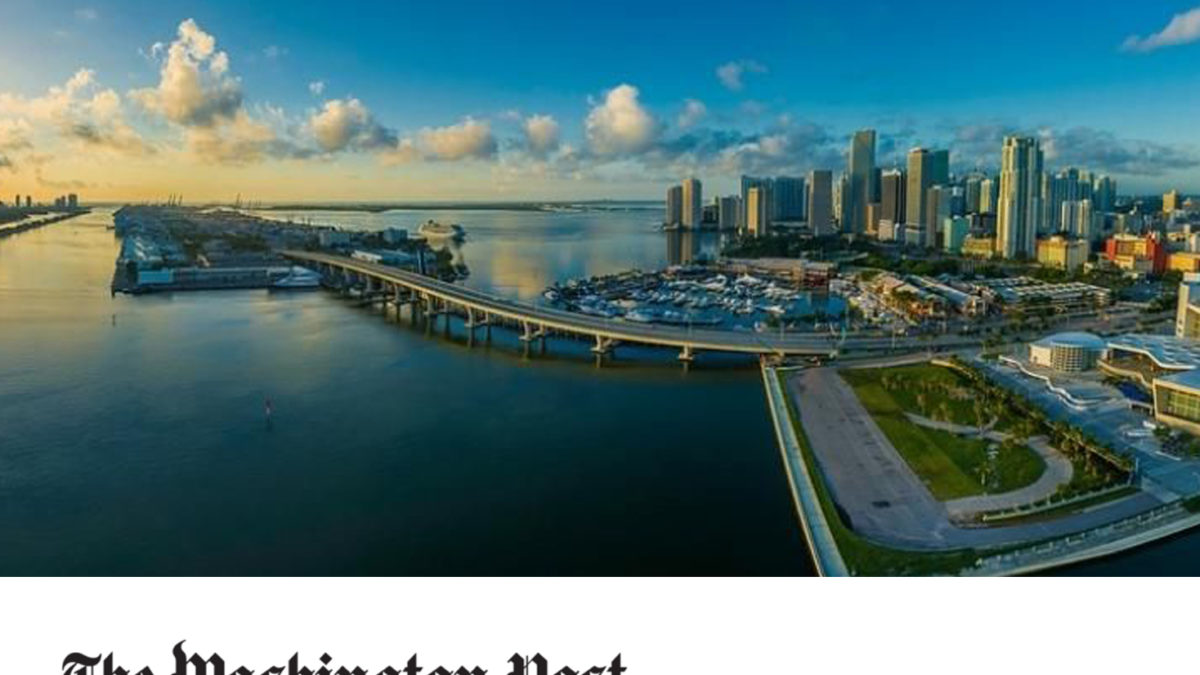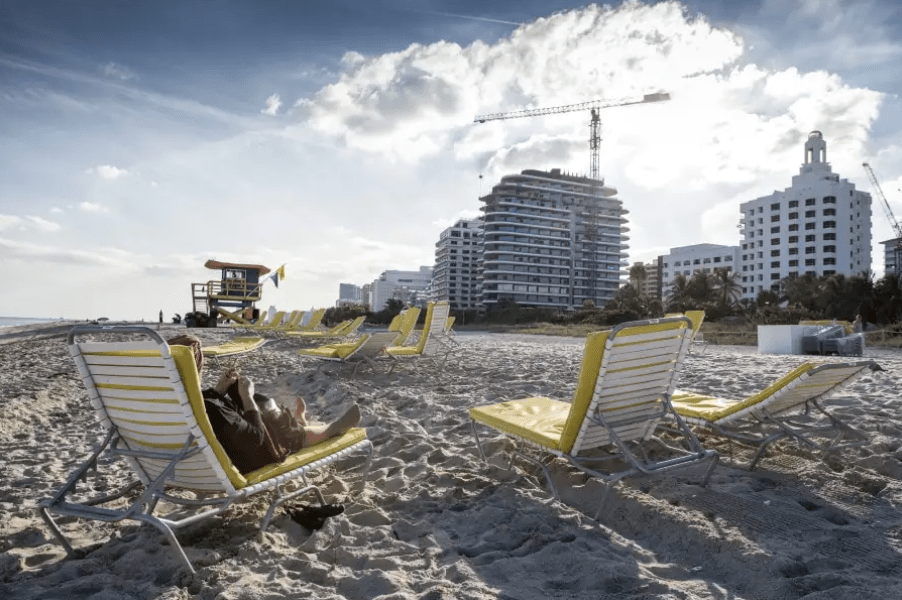

Close



A woman knits in her beach chair at the end of the day on Miami Beach. The Faena construction site can be seen in the background. (Photos by Charles Ommanney for the Washington Post)
In one of cities most vulnerable to climate change, a high-stakes bet to out-build the sea.
But Miami Beach needs this penthouse — and many more like it. The more developers build here, the more taxes and fees the city collects to fund a $300-million storm water project to defend the shore against the rising sea. Approval of these luxury homes on what environmentalists warn is global warming quicksand amounts to a high-stakes bet that Miami Beach can, essentially, out-build climate change and protect its $27 billion worth of real estate.
The move makes budgetary sense in a state with no income tax: Much of South Florida’s public infrastructure is supported by property taxes.
The penthouse and the 46 other luxury condos in “Faena House” have sold out, months before the building is scheduled to open, the developer’s team said. Miami Beach Mayor Philip Levine declared Faena, who designed shirts before towers, “a genius and a visionary.”
“The biggest investors in the world, the smartest minds in the world… they’re all buying,” Levine said. “They believe Miami Beach has a tremendous future, and they put their money where their mouth is.”
Critics question the wisdom of turning high-end properties into climate armor. Existing development already over-stresses Miami Beach’s infrastructure, built decades before sea level worried researchers, Florida State University climatologist David Zierden said. “When you consider current hurricane threats, and the sea level rise that could erode these properties… Common sense says no, you shouldn’t do it.”

The south point area of South Beach in Miami Beach Fla., has massive construction in progress. (Photos by Charles Ommanney for the Washington Post)
By 2020, Miami Beach plans to complete 80 new storm pumps that will collect and banish up to 14,000 gallons of seawater per minute back into Biscayne Bay. Construction started in February. The goal is to reduce sunny day flooding — which frequently invades streets at high tide whether or not it is raining — and prepare the community for future ocean swell.
“We’re showing the world, the investment community — what we do works,” Levine said. “That brings calm, comfort and security to everyone.”
A mock movie poster hangs in his office, featuring “Pump Man” and “King Tide.” Coming soon to a street near you.
The $300 million project is ambitious for a city with a $502 million annual budget. A new stormwater utility fee on homeowners, hotels and stores helped Miami Beach save enough money to borrow the first $100 million.
The project started before planners worked out all the funding. It’s unclear how the city will raise the rest. “We don’t have time for analysis-paralysis,” said Levine. “We are going to have to get creative.”
President Obama’s National Climate Assessment report, released earlier this year, identified Miami as especially vulnerable to the effects of climate change. The ocean around South Florida, which sits on porous limestone, is expected to rise nearly three feet in the next 86 years, according to Florida State University research.
Beaches are already receding. The mayor attended a “sand sampling” last month before ordering replacement reserves: “We were passing bags all around,” Levine said. “I was saying, ‘Bring me that Bahamian white.’”
To compound the problem: Hurricanes may gain strength, researchers predict, and strike more often as average annual temperatures in the southeast heat as much as nine degrees.
Meanwhile, Miami Beach keeps growing. Last year, the city collected $128 million in property taxes, an increase from $117 million in 2013 and $114 million in 2012. Thirty-two new condo towers have been proposed since 2011, said Peter Zalewski, founder of condo consulting site CraneSpotters.com. Twelve are currently under construction. The average asking price for resale condos, he said, is about $1.1 million.
Many buyers come from South America, more concerned by currency instability in their home countries than encroaching saltwater: “They want somewhere safe to park their money,” said Zalewski, whose firm tracks applications. “A lot of buyers here never step foot in the condos. They’ll sell them before the water makes it to the bottom floor of their buildings, anyway.”
Foreign investors fueled nearly one-third of real estate transactions last year in Miami-Dade and Broward counties, according to a National Association of Realtors report. Eighty-one percent paid cash, the report found, and 72 percent bought a condo or townhouse.
There’s little virgin land left. Cranes soar above palm trees, as developers bulldoze and renovate aging buildings to accommodate shinier towers on raised foundations, per city code.
That includes hotels. The Thompson Miami Beach, formerly an apartment building, booked its first guests this month during Art Basel, the festival that annually attracts thousands of big-spending revelers. Mattel hosted a Barbie-themed party at the new hotel — one of five to open this year — where Paris Hilton, dressed as Barbie, spun dance hits behind a pink DJ booth. Miley Cyrus was photographed biting a Barbie’s head.
No one complained about sunny day flooding, which appeared, predictably, at high tide, Thompson’s managing director Brett Orlando said. “They were having a good time partying.”
The Thompson’s 380 new rooms directly boost Miami Beach’s efforts to dry its streets. The new monthly stormwater fee hit all property owners in August. Commercial buildings, like hotels, pay $7 for every 791 square-feet.
Most public improvements are initially financed with bonds, an alternative to higher-rate private loans. That’s only possible if Miami Beach continues to collect money, public works director Eric Carpenter said. Access to cheaper cash accelerates a process that, he said, “absolutely needs to happen, quickly and aggressively.”
Officials want to take advantage of the development spurt while it lasts. “The time to put away things for a rainy day is when it’s sunny outside,” Carpenter said. “If you wait until it’s raining, it’s too late.”
Next March, Miami Beach turns 100. The city will throw a concert on the beach, tentatively starring Gloria Estefan and Pitbull, called “The Miami Beach Centennial Climate Change Concert.”
“Because it’s about about the next hundred years, too,” Levine said. “We’re showing the world that you can fight back.”

Real estate agent Darin Tansey shows multi-million dollar houses to clients on Miami Beach, Fla, Dec. 13. (Photos by Charles Ommanney for the Washington Post)
As the city works to save the land, real estate broker Darin Tansey has no problem selling it. He juggles 50 clients at a time. He wears a $25,000 Audemars Piguet watch. He drives a black Porsche Carrera.
“We’re in a strong economy now because we have cash coming into South Florida,” Tansey said, a vice president of Douglas Elliman, a real estate firm. “There’s capital coming in from all over the world. Construction costs are way up. New buildings are coming in… People are looking for the homes of their dreams.”
On a recent Saturday, he met an Israeli developer looking to spend up to $12 million to buy a mansion, only to destroy it and build a bigger one. The client desired a wide view of Biscayne Bay.
On a recent morning, the first contender was off East San Marino Drive in the Venetian Islands. The client in ripped Dolce and Gabbana jeans liked the waterfront villa. At $8 million, it fit his budget. One problem, he told Tansey: Storm pump work in the neighborhood stalls traffic and shatters his serenity.
There’s another house for sale on Hibiscus Island, Tansey told him, with man-made waterfalls behind the bayfront pool. But Tansey knows it will be hard to avoid construction. Developers pounce on each purchasable lot. City workers have only just started upgrading the flood management infrastructure.
Most of Tansey’s clients are foreign buyers who pay with cash, up to 80 percent. They’ve noticed the sunny day flooding on Miami Beach. They’re heard warnings of catastrophe. Some ask him: Will it cause harm?
“Is this something that could happen in the next 100 years?” said Tansey. “It could happen. But it could not happen.”
Simon Mass, a Canadian real estate investor (and longtime friend of Tansey), plans to buy a $23 million slice of land of North Beach and, as soon as the city grants permission, build a 230-unit condo tower. Many buyers, he predicts, will never visit the properties. They might as well be buying stocks on a computer. “Sea level rise,” he said, “is simply not a concern in those cases. That’s why people have insurance.”
Others are seeking a vacation home, a temporary escape from the sputtering economy in Brazil or political unrest in Venezuela. They flash wealth in South Beach without inviting trouble, Mass said. They drive nuclear-orange Ferraris. They stroll the Lincoln Road Mall in Louboutin heels. They rack up four-figure sushi tabs at Nobu.
“Are they worried about sea level rise?” Mass said. “Do they look like they’re reading the newspaper?”

The city of Miami beach is approving some of the most luxurious and expensive condos in its history in what the Obama administration says is one of the most vulnerable flood plains in the country. The goal is to raise enough money to pay for a massive project to mitigate the rising sea. But critics say the move is an incredible gamble that Miami can out build climate change. (Charles Ommanney for the Washington Post)
Across the island, saltwater swells up street grates. High tide pools below the tires of a silver Audi. Construction workers step over it without glancing down.
A seven-story banner drapes down the old Versailles Hotel, announcing plans by Faena, the Argentine developer, to work architectural magic: Urban Alchemy.
Faena purchased this fading tower and six blocks of Collins Avenue for more than a $1 billion to create a new neighborhood called Faena District Miami Beach. He hired “Moulin Rouge!” director Baz Luhrmann to design a handful of oceanfront penthouses. Models are displayed in a temporary sales office dubbed The Collaboratory. A magnified rose unfurls inside on a flat-screen television.
Faena considers the rose his symbol, a promise to grow something beautiful where nothing special once stood. He works most days in a nearby office, overseeing construction between flights to Buenos Aires, where his first luxury community opened 10 years ago.“Concepts are powerful,” Faena wrote in an e-mail to the Post, “and have the capacity to change and enhance the world.”
Climate change, Faena said, “is a concern of mine.” The parking garage under Faena House, for example, was engineered specifically to keep the water out. Absorbent green space will connect the hotels, condo towers, shops and arts center. A garden will bloom.
And Miami Beach will keep adding storm pumps, supported by the island’s urban alchemy.




